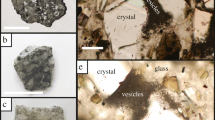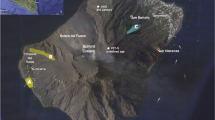Abstract
Obsidian pyroclasts are commonly preserved in the fall deposits of explosive silicic eruptions. Recent work has suggested that they form by sintering of ash particles on the conduit walls above the fragmentation depth and are subsequently torn out and transported in the gas-particle dispersion. Although the sintering hypothesis is consistent with the general vesicle textures and dissolved volatiles in obsidian pyroclasts, previous sintering experiments do not capture all of the textural complexities observed in the natural pyroclasts. Here, we design experiments in which unimodal and bimodal distributions of rhyolitic ash are sintered at temperatures and H2O pressures relevant to shallow volcanic conduits and under variable cooling rates. The experiments produce dense, welded obsidian that have a range of textures similar to those observed in natural pyroclasts. We find that using a unimodal distribution of particles produces obsidian with evenly distributed trapped vesicles, while a bimodal initial particle distribution produces obsidian with domains of poorly vesicular glass among domains of more vesicle-rich glass. We also find that slow cooling leads to resorption of trapped vesicles, producing fully dense obsidian. These broad features match those found in obsidian pyroclasts from the North Mono (California, USA) rhyolite eruption, providing strong support to the hypothesis that obsidian can be produced by ash sintering above the fragmentation depth during explosive eruptions.









Similar content being viewed by others
References
Alfano F, Bonadonna C, Watt S, Connor C, Volentik A, Pyle DM (2016) Reconstruction of total grain size distribution of the climactic phase of a long-lasting eruption: the example of the 2008–2013 Chaitén eruption. Bull Volcanol 78:46
Bonadonna C, Houghton BF (2005) Total grain-size distribution and volume of tephra-fall deposits. Bull Volcanol 67(5):441–456
Cabrera A, Weinberg RF, Wright HMN, Zlotnik S, Cas RAF (2011) Melt fracturing and healing: a mechanism for degassing and origin of silicic obsidian. Geology 39:67–70
Castro JM, Cordonnier B, Tuffen H, Tobin MJ, Puskar L, Martin MC (2012) The role of melt-fracture degassing in defusing explosive rhyolite eruptions at Volcán Chaitén. Earth Planet Sci Lett 333-334:63–69
Castro JM, Bindeman IN, Tuffen H, Schipper CI (2014) Explosive origin of silicic lava: textural and δD–H2O evidence for pyroclastic degassing during rhyolite effusion. Earth Planet Sci Lett 405:52–61
Dunbar NW, Kyle PR (1992) Volatile contents of obsidian clasts in tephra from the Taupo Volcanic Zone, New Zealand: implications to eruptive processes. J Volcanol Geotherm Res 49:127–145
Eichelberger JC, Carrigan CR, Westrich HR, Price RH (1986) Non-explosive silicic volcanism. Nature 323:598–602
Elam WT, Kerstein AR, Rehr JJ (1984) Critical properties of the void percolation problem for spheres. Phys Rev Lett 52(17):1516–1519
Gardner JE (2007) Bubble coalescence in rhyolitic melts during decompression from high pressure. J Volcanol Geotherm Res 166:161–176
Gardner JE, Ketcham RA (2011) Bubble nucleation in rhyolite and dacite melts: temperature dependence of surface tension. Contrib Mineral Petrol 162:929–943
Gardner JE, Llewellin EW, Watkins JM, Befus KS (2017) Formation of obsidian pyroclasts by sintering of ash particles in the volcanic conduit. Earth Planet Sci Lett 459:252–263
Gardner JE, Wadsworth FB, Llewellin EW, Watkins JM, Coumans JP (2018) Experimental sintering of ash at conduit conditions and implications for the longevity of tuffisites. Bull Volcanol 80:23
Gonnermann HM, Manga M (2005a) Nonequilibrium magma degassing: results from modeling of the ca. 1340 AD eruption of Mono Craters, California. Earth Planet Sci Lett 238(1):1–16
Gonnermann HM, Manga M (2005b) Flow banding in obsidian: a record of evolving textural heterogeneity during magma deformation. Earth Planet Sci Lett 236(1):135–147
Gottsmann J, Giordano D, Dingwell DB (2002) Predicting shear viscosity during volcanic processes at the glass transition: a calorimetric calibration. Earth Planet Sci Lett 198(3–4):417–427
Hess K–U, Dingwell DB (1996) Viscosities of hydrous leucogranitic melts: a non–Arrhenian model. Am Mineral 81:1297–1300
Jaupart C, Allegre CJ (1991) Gas content, eruption rate and instabilities of eruption regime in silicic volcanoes. Earth Planet Sci Lett 102:413–429
Kaminski E, Jaupart C (1998) The size distribution of pyroclasts and the fragmentation sequence in explosive volcanic eruptions. J Geophys Res 103(B12):29759–29779
Kertész J (1981) Percolation of holes between overlapping spheres: Monte Carlo calculation of the critical volume fraction. J Physique Lett 42(17):393–395. https://doi.org/10.1051/jphyslet:019810042017039300
Liu Y, Zhang Y, Behrens H (2005) Solubility of H2O in rhyolitic melts at low pressure and a new empirical model for mixed H2O-CO2 solubility in rhyolitic melts. J Volcanol Geotherm Res 143:219–235
McIntosh IM, Llewellin EW, Humphreys MCS, Nichols ARL, Burgisser A, Schipper CI, Larsen JF (2014) Distribution of dissolved water in magmatic glass records growth and resorption of bubbles. Earth Planet Sci Lett 401:1–11
Newman S, Epstein S, Stolper E (1988) Water, carbon dioxide and hydrogen isotopes in glasses from the ca. 1340 A.D. eruption of the Mono Craters, California: constraints on degassing phenomena and initial volatile content. J Volcanol Geotherm Res 35:75–96
Okumura S, Nakamura M, Nakashima S (2003) Determination of molar absorptivity of IR fundamental OH stretching vibration in rhyolitic glasses. Am Mineral 88:1657–1662
Okumura S, Nakamura M, Takeuchi S, Tsuchiyama A, Nakano T, Uesugi K (2009) Magma deformation may induce non-explosive volcanism via degassing through bubble networks. Earth Planet Sci Lett 281(3–4):267–274
Pitzer KS, Sterner SM (1994) Equations of state valid continuously from zero to extreme pressures for H2O and CO2. J Chem Phys 101:311
Rust AC, Cashman KV (2007) Multiple origins of obsidian pyroclasts and implications for changes in the dynamics of the 1300 B.P. eruption of Newberry Volcano, USA. Bull Volcanol 69:825–845
Rust AC, Cashman KV, Wallace PJ (2004) Magma degassing buffered by vapor flow through brecciated conduit margins. Geology 32:349–352
Taylor BE (1991) Degassing of Obsidian Dome rhyolite, Inyo volcanic chain, California. Geochem Soc Spec Publ 3:339–353
Taylor BE, Eichelberger JC, Westrich HR (1983) Hydrogen isotopic evidence of rhyolitic magma degassing during shallow intrusion and eruption. Nature 306:541–545
Tuffen H, Dingwell DB (2005) Fault textures in volcanic conduits: evidence for seismic trigger mechanisms during silicic eruptions. Bull Volcanol 67(4):370–387
Tuffen H, Dingwell DR, Pinkerton H (2003) Repeated fracture and healing of silicic magma generate flow banding and earthquakes? Geology 31:1089–1092
Vasseur J, Wadsworth FB (2017) Sphere models for pore geometry and fluid permeability in heterogeneous magmas. Bull Volcanol 79(11):77
Wadsworth FB, Vasseur J, von Aulock FW, Hess KU, Scheu B, Lavallée Y, Dingwell DB (2014) Nonisothermal viscous sintering of volcanic ash. J Geophys Res 119:8792–8804
Wadsworth FB, Vasseur J, Llewellin EW, Schauroth J, Dobson KJ, Scheu B, Dingwell DB (2016) Sintering of viscous droplets under surface tension. Proc R Soc A 472(2188):20150780
Wadsworth FB, Vasseur J, Llewellin EW, Dobson KJ, Colombier M, von Aulock FW, Fife JL, Wiesmaier S, Hess KU, Scheu B, Lavallée Y (2017) Topological inversions in coalescing granular media control fluid-flow regimes. Phys Rev E 96(3):033113
Walker GPL (1981) Plinian eruptions and their products. Bull Volcanol 44:223–240
Watkins JM, Gardner JE, Befus KS (2017) Non-equilibrium degassing, regassing, and vapor fluxing in magmatic feeder systems. Geology 45:183–186
Zhang Y, Ni H (2010) Diffusion of H, C, and O components in silicate melts. Rev Mineral Geochem 72:171–225
Zhang Y, Belcher R, Ihinger PD, Wang L, Xu Z, Newman S (1997) New calibration of infrared measurement of dissolved water in rhyolitic glasses. Geochim Cosmochim Acta 61:3089–3100
Acknowledgements
JEG and JMW were partially supported by grants from the National Science Foundation (EAR–1725186 and EAR–1725207). EWL and JPC acknowledge support from the UK Natural Environment Research Council via grant NE/N002954/1. FBW acknowledges a fellowship from the Centre for Advanced Study at the Ludwig-Maximilians-Universität, Munich. All data from the study can be obtained from JEG. The authors thank two anonymous reviewers and the Associate Editor for their insights, which have improved the manuscript.
Author information
Authors and Affiliations
Corresponding author
Additional information
Editorial responsibility: M.I. Bursik
Appendix 1
Appendix 1
Whether there is enough time for silicate melt to flow viscously to allow the bubbles to shrink depends on the timescale for H2O to resorb from vesicles (λγ) and the characteristic time required for the melt to flow (λη). Both timescales are functions of solubility (Ce), diffusivity (D), and melt viscosity (η), all of which are functions of temperature (Fig. 10), and so, they change through the cooling ramp. The curves for Ce(T) and D(T) also require a dissolved water content to be assumed. We choose Ce, 0, which is the initial solubility of water in the melt, in wt.%, at the start of the cooling ramp. This is the lowest dissolved water content anticipated during the experimental run. This value yields the highest viscosity and slowest diffusivity and so constitutes the most conservative assumption. In our analysis, we use the time-averaged values of each parameter over the linear cooling ramp: \( \overline{C_e} \), \( \overline{D} \), and \( \overline{\eta} \), respectively.
In order to estimate λγ, we first calculate the mass (M0) of H2O contained within a bubble of initial radius (R0) at the start of the cooling ramp, using the equation of state of Pitzer and Sterner (1994). We then calculate the volume (V) of melt that would be required to resorb this mass of water:
where M0(R0, P, T0) indicates that M0 is a function of initial bubble radius, experimental pressure, and initial temperature (via the equation of state), and ρm is density of the melt, taken as 2300 kg m−3. We assume that, if resorption goes to completion, then V will be a sphere of hydrated melt with radius \( {R}_h=\sqrt[3]{3V/4\pi } \). The characteristic diffusion length scale at the end of the cooling ramp is estimated as \( {l}_D=\sqrt{\overline{D}t} \). By setting lD = Rh, we can estimate the duration of the cooling ramp required to fully resorb the water in the bubble by diffusion:
The characteristic time required for the melt to flow viscously to allow the bubble to collapse is estimated by assuming that it scales with the ratio of the viscosity of the melt to the stresses driving collapse, which are the surface tension (Laplace) stress σ and the confining pressure, given by
Solid curves are solubility (Ce), diffusivity (D), and viscosity (η) as functions of temperature, all at 22 MPa H2O pressure. Dash lines are time-averaged values of each during constant rate cooling from 750 to 550 °C. Diffusivity and viscosity are calculated under the conservative assumption that dissolved H2O content is given by solubility at 750 °C
Rights and permissions
About this article
Cite this article
Gardner, J.E., Wadsworth, F.B., Llewellin, E.W. et al. Experimental constraints on the textures and origin of obsidian pyroclasts. Bull Volcanol 81, 22 (2019). https://doi.org/10.1007/s00445-019-1283-z
Received:
Accepted:
Published:
DOI: https://doi.org/10.1007/s00445-019-1283-z





